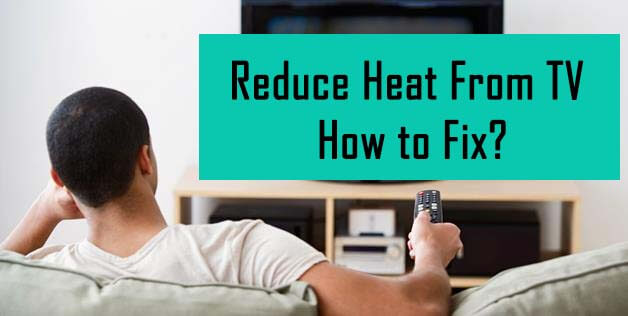“As an Amazon Associate, I earn from qualifying purchases. Without Any Extra Cost to You!”
No doubt, television is one of the most wonderful inventions of modern science. Coming with numerous advantages, televisions are not without their downsides.
When it comes to disadvantages, the first thing is mechanical issues. That is, your TV is getting hot. Now the question is what is the solution to this problem? There are processes that you can take to solve this problem.
Heat is a type of energy that makes you feel cold and hot. That means heat flows from warmer objects to cooler objects.
Today, we are here to give you a perfect solution to reduce heat from TV.
Let’s dive in deep…
- Reasons Why My TV Is Overheated
- Reduce Heat From TV- How to Fix?
- Let’s face a Case Study
- How to change image mode from vivid to standard
- How to change the brightness
Reasons Why My TV Is Overheated

Now, let’s see what is the general method of lowering the TV temperature when your TV is overheating.
The first thing you can do for reducing the heat of your TV-
Drag the video settings through the menu/picture settings. Keep the value around 80 percent or less and check if the problem is okay.
If your TV shuts off for five minutes to an hour, that means the heat is still too high. If you still notice that the temperature of the TV is rising and rising, what is the real reason then?
Another important thing to look at is whether the TV has adequate ventilation, whether the power consumption is increasing, whether the image mode has been changed from partition to standard to produce less heat.
If your television is still hot, realize that your TV does not have adequate ventilation. Either the power consumption is increasing, or the image mode has not changed from partition to standard to produce less heat.
Again, some people keep their TV in a place at home where the sunlight falls directly on the television. However, the sunlight does a lot of damage to a television.
In addition, TVs are affected on winter days or in humid environments. Moreover, extreme heat, cold, humidity, or humidity can permanently damage the display on a flat-screen television.
Humidity can shorten the circuit inside your TV, while extreme heat or cold can disrupt the pixel’s ability to change color properly.
Excessive heat can permanently damage a TV. The most obvious sign of overheating is a sudden shutdown when the TV can no longer run properly.
You may interested in fixing the TV screen horizontal line
How do I stop my TV from overheating?

Overheating is easy to fix in most cases, requiring a little more than some replacement or cleaning. Those of us who are going to buy a TV or those who are going to buy a TV in the future, before buying a TV you have to look at various things like:
- Whether the TV has a ventilation system
- How to reduce the power consumption
- How to change the image mode from partition to standard.
Plus, you should know how many bulbs are needed to equalize the power output of a TV set. There are a number of reasons to determine this, such as the wattage of a standard light bulb and the wattage of a TV.
You may read also the soundbar for wall TV
Let’s face a Case:

I was interested in the power consumption of my 48 “LCD flat-screen TV, as I could feel it when the heat was on and off.
Which does not help to feel cold in the summer season) I realized that it must use one ton of energy! Depending on the size of the old color TV sets with cathode ray tube (CRT) has a power consumption range of 65-133 watts:
Estimating Appliance And look at the general wattage of different applications under Home Electrical Power Consumption.
So, if you compare 100W light bulbs with a television set that uses 100W, they must use the same amount of power. Liquid crystal displays or more new flat-screens like plasma.
The technology offers additional benefits such as lighter weight, slimmer shape, and better quality images in addition to energy savings when compared to size.
Provides a list of quality, energy-saving televisions, and searchable databases. Among the various types of TVs, Energy Star’s list of LCD TVs includes screen-sized models from 16-65 inches, with a range of 18.5W-198W when the TV is turned on.
Plasma TVs up to 42-65 inches use 90W-214W when powered. Now, if you compare a 32-inch LCD TV that uses 50 watts when powered by a 100-watt light bulb, you need two TVs to equalize the bulb output.
The best TV is to turn off your TV and lights when they are not in use. Or take it one step further by using a smart power strip to limit the vampire power of all devices in your leisure center or home office.
This applies to different types of products. One of its products is TV. When buying a TV, it is better to check the following things.
The TV may feel warm or hot to the touch even after several hours of use. For example, LCD TVs are thinner and the cabinet perimeter is relatively small, the heat generated by the LED backlight located at the bottom or side of the TV is more noticeable.
Warm temperatures should not be considered a cause of normal operation and anxiety. It does not indicate any defect and does not affect product reliability or life.
As with most electronics products, it is important to ensure that the TV has adequate ventilation to avoid overheating.
Also, please change the image mode from partition to standard to reduce power consumption and produce less heat.
You can use a Hygrometer from Amazon to measure the heat of your TV.
If you want to know one specific model of Hygrometer, this is my recommended Hygrometer.
You may be interested in the Westinghouse TV soundbar
How to change image mode from vivid to standard:
1. Press the home button on your remote.
2. After selecting the settings you have to select the display in the TV section.
3. Picture Image must be selected.
4. The picture mode must be selected.
5. The standard must be selected.
How to change the brightness:
1. Press the home button on the remote. If your TV has no remote, then you may check this TV remote from Amazon
2. Select the settings.
3. Choose the display in the TV section.
4. Select the picture.
5. Select the brightness and adjust the brightness level to a minimum.
This is something to keep in mind: please use the TV between 0 C to 40 C (32F to 104 F) and not expose the TV to direct sunlight. In the end, there is nothing to worry about if the TV heats up. If we notice the above issues, you can get rid of them.
This is one way I have found to fix a heating TV. My LG TV would create a loud pop and then flash the screen before going black and turning off and wouldn’t turn back on for about 30mins. I was able to fix it with some laptop fans. Enjoy and hope this helps someone.
Let’s Wrap Up!
This is all for this time to fix the problem.
Hopefully, you already have reduced the heat of your TV.
By reading this article on how to reduce heat from TV, you will be able to make quick fixes and responses.
